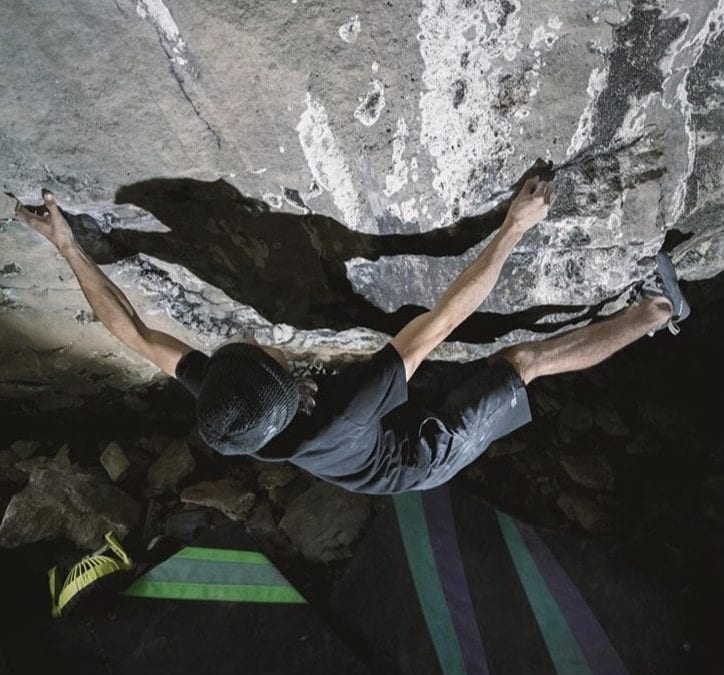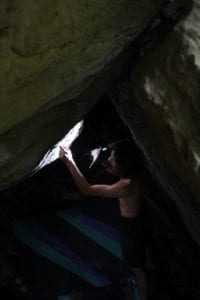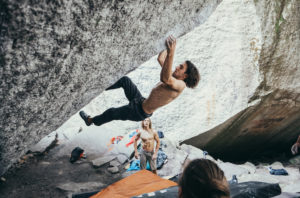Ethan Salvo and Ontario’s Hardest Boulder Problem
Ontario's Ethan Salvo describes his process establishing and grading Ontario's hardest boulder problem: Rite of Passage Low V13/14
 Photo by: Ilya Sarossy
Photo by: Ilya Sarossy
“I’m trying to climb something,” said Ethan Salvo. “I am not trying to be better than anyone else. The rock does not care about me.”
There is difficulty in grading. Perhaps that much is obvious, grading is an expression of difficulty, but it is also more than that. For better or worse, climbers love grades. They represent progression, a challenge, and are a flashy way to tell other climbers just how sick they really are.
Climbers also hate grades. In two or three characters, months or years of work are boiled down to 5.10, V10, A4, or what-have-you. In conversation with B.C. climber Brennan Doyle, the 17-year-old was hesitant to grade his recently established Shadow Realm. On the other side of the country, Ethan Salvo became hesitant to rate his recently established low start to Rite of Passage.

Perhaps this is because these two crushes are modest climbers, they surely are. Perhaps it is because difficulty is relative, it surely is. In Salvo’s case, however, one thing sticks out. He said, “Personally I think it is hard, but from a media stand point, I don’t want to deal with people questioning me. I don’t want to have to deal with that validation.”
What happens when the youngest in our sport, those who represent some of the strongest outdoor boulderers in the country, cannot feel comfortable expressing their work? Perhaps it is important to remember that grades are only a perspective. They are never fixed.
In either case, Salvo has been climbing for nearly three years. In this time, he has accomplished some of the province’s hardest problems. His story takes us through a year of competition climbing, abandoned for outdoor boulder problems. Salvo climbs at the Glen.
Perhaps the most under-credited crag in the country, the slippery Dolomite that defines the area has been criticized for its chossy demeanor. The powerful, grip-intensive climbing style, however, is unique in Canadian bouldering and requires absolute precision.
Among the variety of double-digit boulders and open projects, there has always been one that all Glen climbers dreamt of completing: The Stairwell Project.
Salvo got psyched following the completion of his longstanding project. “After doing the (now broken) Crucifix Project the summer of 2019, I got super stoked. I thought I might try the Stairwell Project. Maybe it’s possible.”
The project had been tried for decades. It would not be until Japan’s Kaito Watanabe visited the Glen that the crux beta would be unlocked.

Salvo said, “That September, Kaito Watanabe came out to the Glen. He found this tiny little mini-pinch. It would be horrible if it weren’t for these teeth that sink into your skin. He became the only person in 20-years to have done the move to the small crimp.”
Still, Watanabe didn’t do the top. Though the climbing eases after the crux, the risk involved increases dramatically. The last few moves push the climber through increasingly steep roof. The moves increase in length and pitch the climber’s back over a stone staircase, 15-feet below.
In March of 2020, just days before the Glen locked down, Salvo would complete the stand. He would name the boulder Rite of Passage grading it V12. “A week later I was putting up two-by-fours in my backyard because all the gyms had shut down.”
As lockdown began, Salvo contemplated what the next project would be. “I knew there was a sit-start and I wanted to try it as soon as the Glen opened. I trained in my basement for three-months straight. I got strong. I felt like I was at peak fitness. I got to the Glen when it reopened in June. First session back, third-day-on, within an hour of playing around with the sit, I figured out the beta. I thought, ‘Well, that can’t be that hard, it’s going to go down next time I come back.’ Then every other time I came back it didn’t go at all.
“I couldn’t even link back into the stand. I couldn’t ever repeat the stand. I kept going back every single week, if not twice a week, to go try it after I had done all of the moves. What I didn’t realize was that doing the moves is not the crux of the boulder. The crux is doing the whole thing. You can climb into the crux of the stand and pull the move and almost hit it and you are still miles away from doing it. At least that’s what it was for me. It’s just crazy.”
As time passed, the difficult-to-pad problem began to weigh on the young climber. By session five, doubt had crept in. By August, he would give it up, awaiting the cooler temperatures and lower humidity of fall. Shifting focus, he would look to Squamish.
In the Grand Wall and the Apron, Salvo would complete a number of hard boulders.
“Coming back from Squamish, I had this ego: ‘Look at all of these hard things that you did. You’re more than capable of doing it so you are just going to do it.’ Halfway through that first session back in the Glen, my heel kept popping on the third move.”
Salvo’s frustration mounted after falling on moves he previously cruised. He got lost in his own head.

“The session after that, there were probably six or seven people there, and I just needed to be at the boulder by myself. It had become so toxic. I hated my friends being there. I hated that they were having a good time. My ego got to the point where I was like, ‘Why are you goofing around? I am trying to do serious shit here. Why are you not taking this as seriously as I am?’ It was so shitty of me. It was so unfair to be thinking like that, and the trick for me was to go back and let go of my ego and everything.
With a renewed sense of peace, Salvo relaxed, thinking, “‘I’m here, it’s okay if this isn’t the day.’ I then had my best go ever. Move-wise, I was falling in exactly the same place, but you can look at the clip and I am visibly in the hold and pulling down on it for like a quarter of a second. Cam said, ‘That was it,’ and I felt like that was it, but I also knew that it might only be a little step forward. I decided I was going to stay neutral.”
“Literally 10-minutes before I did it, I was like ‘This could or could not go.’ I could still be sessions away from doing this thing. From here on out, I am going to keep coming. I had to learn to calm myself and really be present in the moment. The wind kicked up. ‘This is going down now.’”
“I remember pulling the first move and hitting the three-finger pocket. I was going through the foot sequence quite slow compared to other burns, breathing very slow through the bottom. I hit everything really well. I knew I was going to do it when I was doing the match. ‘I’m just going to hold there.’ I stepped on the nothing left foot, put the toe on, grabbed the crimp, did the foot bump, picked up the breathing: ‘one, two, three: onto the pinch.’ I crimped with my left so hard, fully super-crimping this massive edge, did the foot cut, put the foot on perfect and pulled.”
“I remember catching it. In the video you see me scream three times because I didn’t have the crimp good. I was just fighting with everything. I had to stay on this hold. I remember getting it and just yelling for three foot-moves. It wasn’t even a thought, I was just flowing, but in the most try hard way ever. I almost fell three times getting the second-to-last hold. Once I got there, I put the foot in, looked back and hit the tick. As soon as I was in the air, there was this half-thought of, ‘I am in the air, flying over stairs. Don’t dab.’ I don’t know if I have ever had to do that much on one boulder. So many boulders feel easy when you do them, but this one felt insane.”

“I didn’t want to propose the full 14, even though I logged it at that. That’s what it felt like to me. Soft V14. The reason that I logged it at the slash grade was that no one else has done the stand start. Quite honestly, I think it is harder than I graded it. The crux move, in isolation, is harder than every single move on every power endurance boulder I have done.”
“I was hesitant to go full 14 because of the media. You hear these stories of hard climbers throwing these massive numbers out there for the media and that’s not what I wanted. I knew by session eight or nine that this thing was much harder than I thought it would be. I don’t know. Shelter, I really didn’t have to try too hard for. If you ask me, that crux move, in isolation, is only a little bit easier than the first move of Shelter. It is a hard move. If the boulder ended there, I could maybe see it being 13/14, but, quite honestly, those ending last moves add something. I don’t know if it is a mental thing, but it’s not over until it’s over.”
“I am also hesitant to call it V14 because I am sure that there are people out there that are more than capable of it too. Personally I think it is that hard, but from a media stand point, I don’t want to deal with people questioning me. I don’t want to have to deal with that validation. I am just going to call it what I want. I know someone could do it and be like this is V13. I could totally see that. Someone could also do the stand and be like, I think this is low-end V13 and I would be like, I can totally see that too.”
After 10 full sessions on the stand and another 11 sessions on the sit, Salvo is looking at yet another boulder problem on the same wall. Beginning on the right side of the cave, is a project built out of small edges and large spans.
Looking forward, Salvo said, “My goal for the rest of the year is to do that bottom boulder. Honestly, If I can do the bottom boulder, I will be surprised. It’s hard. The bottom alone would be limit or close to limit.”
Though the future looks uncertain, Salvo is hopeful that some of Canada’s strongest will come and test themselves on Rite of Passage and its lower start. The challenging boulder problem is rarely attempted by climbers in the area, though it represents some of the best climbing the Glen has to offer.


